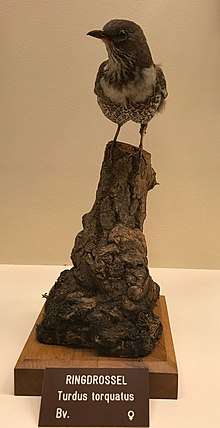Ring ouzel
The ring ouzel (Turdus torquatus) is a European member of the thrush family, Turdidae. It is the mountain equivalent of the closely related common blackbird, and breeds in gullies, rocky areas or scree slopes.
| Ring ouzel | |
|---|---|
_a_(4834220566).jpg) | |
| Scientific classification | |
| Kingdom: | Animalia |
| Phylum: | Chordata |
| Class: | Aves |
| Order: | Passeriformes |
| Family: | Turdidae |
| Genus: | Turdus |
| Species: | T. torquatus |
| Binomial name | |
| Turdus torquatus | |
Nomenclature
"Ouzel" (or "ousel") is an old name for common blackbird. The word is cognate with German "Amsel". "Ouzel" may also be applied to a group of superficially similar but more distantly related birds, the dippers, the European representative of which is sometimes known as the water ouzel.
As with the English name, the scientific name also refers to the male's obvious white neck crescent, being derived from the Latin words turdus, "thrush", and torquatus, "collared".[2]
Taxonomy
About 65 species of medium to large thrushes are in the genus Turdus, characterised by rounded heads, longish, pointed wings, and usually melodious songs. Although two European thrushes, the song thrush and mistle thrush, are early offshoots from the Eurasian lineage of Turdus thrushes after they spread north from Africa, the ring ousel is descended from ancestors that had colonised the Caribbean islands from Africa and subsequently reached Europe from there.[3]
Description
The adult male is all black except for a white crescent on the breast and a yellowish bill. The wings have a silvery appearance due to white feather edgings. The male sings its loud and mournful song from trees or rocks.
The female is similar but duller, and younger birds often lack the breast crescent. The juvenile has brown plumage.
This species was first described by Carl Linnaeus in his landmark 1758 10th edition of Systema Naturae under its current scientific name.[4]
Behaviour and ecology
It breeds in the higher regions of western and central Europe and also in the Caucasus and in the Scandinavian mountains. Most populations are migratory, wintering in the Mediterranean region. It is declining in parts of its range, particularly in Ireland, where breeding is now largely confined to two counties, Donegal and Kerry, and there are fears that it may soon become extinct there.

It is territorial and normally seen alone or in pairs, although loose flocks may form on migration. When not breeding, several birds may also be loosely associated in good feeding areas, such as a fruiting tree, often with other thrushes.
Diet
The ring ouzel is omnivorous, eating a wide range of insects, earthworms, small rodents, reptiles and berries.
Nesting
The ring ouzel nests in bushes or amongst rocks, laying several pale blue eggs, mottled with brown, in a neat cup-shaped nest.
References
- BirdLife International (2012). "Turdus torquatus". IUCN Red List of Threatened Species. 2012. Retrieved 26 November 2013.CS1 maint: ref=harv (link)
- Jobling, James A (2010). The Helm Dictionary of Scientific Bird Names. London: Christopher Helm. pp. 388, 393. ISBN 978-1-4081-2501-4.
- Reilly, John (2018). The Ascent of Birds. Pelagic Monographs. Exeter: Pelagic. pp. 221–225. ISBN 978-1-78427-169-5.
- Linnaeus, Carl (1758). Systema naturae per regna tria naturae, secundum classes, ordines, genera, species, cum characteribus, differentiis, synonymis, locis. Tomus I. Editio decima, reformata. (in Latin). Holmiae. (Laurentii Salvii). p. 169.
T. nigricans, torque albo, rostro fiavescente.
Bibliography
- Clement and Hathaway, Thrushes ISBN 0-7136-3940-7
External links
| Wikimedia Commons has media related to Turdus torquatus. |
| Wikispecies has information related to Turdus torquatus |
